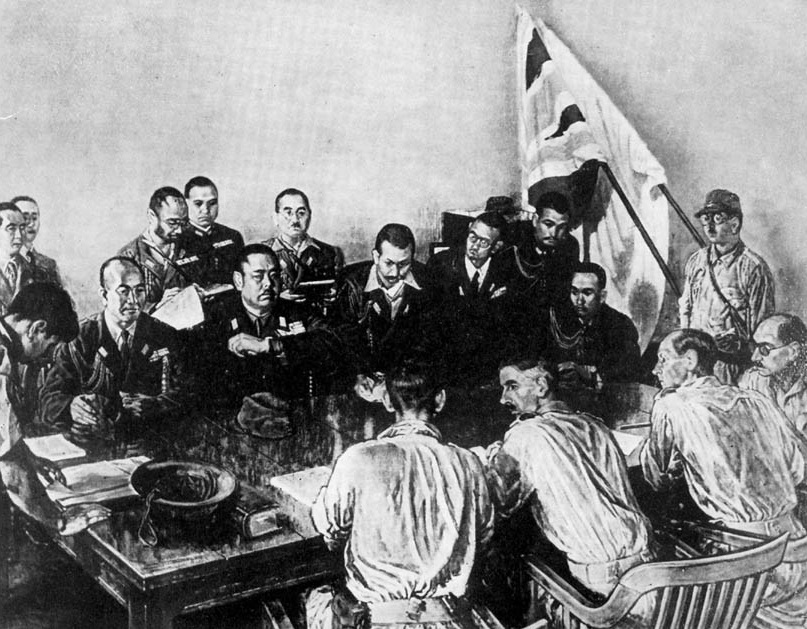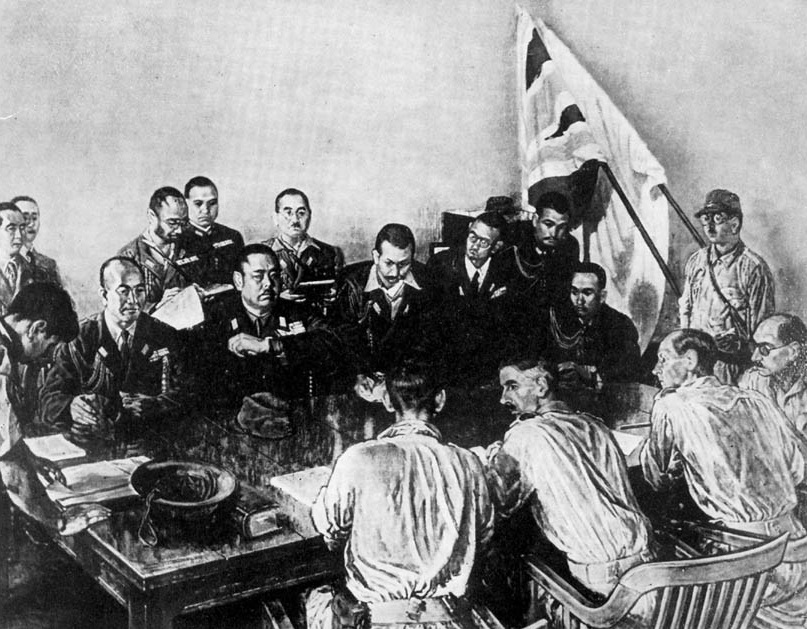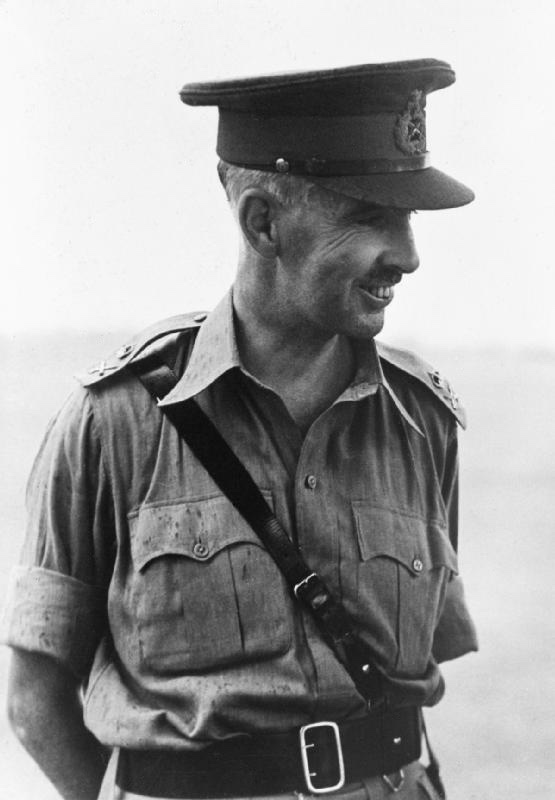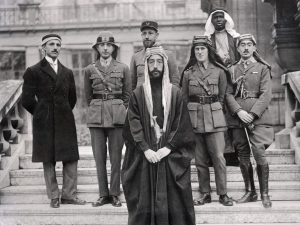Finest Hour 169
Churchill and the Fall of Singapore

November 10, 2015
Finest Hour 169, Summer 2015
Page 32
By By Fred Glueckstein
Fred Glueckstein is a member of The Churchill Centre and author of Churchill and Colonist II: The Story of Winston Churchill and His Famous Race Horse (2014).
 Lieutenant-General A. E. Percival signs the surrender at Singapore. The Japanese leader is Lieutenant-General T. Yamashita.During the last week in March 1941, as a result of Britain’s capability to read Japanese top-secret diplomatic telegrams, Winston Churchill was able to follow the travels and discussions of the Japanese Foreign Minister, Yosuke Matsuoka, in Rome, Berlin, and Moscow. While Matsuoka was in Berlin, he was pressed, on Hitler’s authority, to agree to a Japanese attack on British possessions in the Far East as soon as possible. Matsuoka was told an attack on Singapore would be a decisive factor in the speedy overthrow of England.
Lieutenant-General A. E. Percival signs the surrender at Singapore. The Japanese leader is Lieutenant-General T. Yamashita.During the last week in March 1941, as a result of Britain’s capability to read Japanese top-secret diplomatic telegrams, Winston Churchill was able to follow the travels and discussions of the Japanese Foreign Minister, Yosuke Matsuoka, in Rome, Berlin, and Moscow. While Matsuoka was in Berlin, he was pressed, on Hitler’s authority, to agree to a Japanese attack on British possessions in the Far East as soon as possible. Matsuoka was told an attack on Singapore would be a decisive factor in the speedy overthrow of England.
After reading Matsuoka’s own top-secret account of the German pressure, Churchill sent him a message with eight questions designed to make Japan pause before committing its fleets and armies against Britain.1
With respect to an attack on Singapore, Churchill initially had little real concern about a Japanese assault. Between the World Wars, he and the British public, through the press, were convinced that the colony, an island off the tip of the Malay peninsula in Southeast Asia, was an invincible fortress. Churchill touted it as the Gibraltar of the East.
Churchill and the Admiralty believed Singapore impregnable because the Naval Base protected the city from attack by sea, while to the north of the island, on the mainland, hundreds of miles of dense jungle appeared to be impenetrable. Furthermore, stationed on the island were almost 100,000 British, Canadian, Australian, Indian, and a few Malayan troops.
Fortress in Jeopardy
Churchill’s attention did turn to Singapore when the Japanese were in a position to threaten the Malay Peninsula in January 1942. On the fifteenth he wrote General Wavell, Commander-in-Chief of ABDACOM (American-British-Dutch-Australian Command), about Singapore. “Please let me know your idea of what would happen in event of your being forced to withdraw into the island,” requested Churchill. “How many troops would be needed to defend this area? What means are there of stopping landings (such) as were made in Hong Kong? What are defences and obstructions on landward side? Are you sure you can dominate with fortress cannon any attempt to plant siege batteries?” Churchill continued: “Is everything being prepared, and what has been done about the useless mouths? It has always seemed to me that the vital need is to prolong the defence of the island to last possible minute. But of course I hope it will not come to this….”2
On 16 January, Wavell wrote him a most disturbing reply: “I discussed the defence of island when recently at Singapore, and have asked for detailed plans. Until quite recently all plans were based on repulsing seaborne attacks on island and holding land attack in Johore [located in the southern portion of the Malay Peninsula] or farther north, and little or nothing was done to construct defences on north side of the island to prevent crossing Johore Straits, though arrangements have been made to blow up the causeway.”
Wavell went on to say: “The fortress cannon of heaviest nature have all-round traverse, but their flat trajectory makes them unsuitable for counter-battery work. Could certainly not guarantee to dominate enemy siege batteries with them.”3
Churchill was clearly astounded, and greatly troubled, by Wavell’s message. He responded: “It was with feelings of painful surprise that I read this message on the morning of the 19th. So there were no permanent fortifications covering the landward side of the naval base and of the city! Moreover, even more astounding, no measures worth speaking of had been taken by any of the commanders since the war began, and more especially since the Japanese had established themselves in Indo-China, to construct field defences. They had not even mentioned the fact that they did not exist.”4
On 19 January, Churchill wrote to General Ismay, his military adviser and link with the Chiefs of Staff Committee, about Singapore. “I must confess to being staggered by Wavell’s telegram of the 16th and other telegrams on the same subject. It never occurred to me for a moment…that the gorge of the fortress of Singapore, with its splendid moat half a mile to a mile wide, was not entirely fortified against an attack from the northward.”5
Churchill asked Ismay that a plan be made at once while the battle in Johore was going forward. He outlined what the plan should comprise. Among the ten elements of the plan, Churchill included: “(i) Not only must the defence of Singapore Island be maintained by every means, but the whole island must be fought for until every single unit and every single strong point has been separately destroyed. (j) Finally, the city of Singapore must be converted into a citadel and defended to the death. No surrender can be contemplated, and the Commander, Staffs and principal officers are expected to perish at their posts.”6
In his memoirs, Ismay told of reporting to Churchill on the morning of 19 January: “I found him in a towering rage. Why had I not told him that there were no defences on the north side of Singapore Island? Before I could protest that he must have been misinformed, he thrust into my hand a telegram from Wavell reporting that little or nothing had been done in the way of constructing defences to prevent the crossing of the Johore Straits. I could scarcely believe my eyes.
“The Prime Minister continued: ‘You were with the Committee of Imperial Defence (CID) for several years before the war broke out. You must have known the position. Why did you not warn me?’”
Ismay wrote that he was tempted to explain to Churchill that the CID had concerned itself with the installation of the heavy guns to meet a sea-borne attack and with the period for which the fortress had to be prepared to hold out until relief arrived. In addition, it had been taken for granted that the commanders on the spot would see to the local defenses against land attack from the north. “But I remained silent,” Ismay wrote, “What did my own feelings matter when so ghastly and humiliating a disaster loomed ahead?”7
On 3 February, Churchill had lunch with King George VI at Buckingham Palace. Among the discussions was Singapore. The King entered the following entry in his diary: “The PM is worried & angry over events in the Far East. Singapore has not been fortified from the land-ward side even with tank traps & pill boxes hidden in the jungle. These could have been done by the troops themselves. 15 [inch] gun emplacements pointing out to sea are no form of defence. He fears great loss of life by air bombardment.”8
In The Hinge of Fate, Churchill ultimately took responsibility for the lack of permanent fortifications: “I do not write this in any way to excuse myself. I ought to have known. My advisers ought to have known and I ought to have been told, and I ought to have asked. The reason I had not asked about this matter, amid the thousands of questions I put, was that the possibility of Singapore having no landward defences no more entered into my mind than that of a battleship being launched without a bottom.”
Churchill continued: “I am aware of the various reasons that have been given for this failure: the preoccupation of the troops in training and in building defence works in Northern Malaya; the shortage of civilian labour; pre-war financial limitations and centralized War Office control; the fact that the Army’s role was to protect the naval base, situated on the north shore of the island, and that it was therefore their duty to fight in front of that shore and not along it. I do not consider these reasons valid. Defences should have been built.9
The Attack Begins
Japan’s Malayan campaign started on the night of 7 December 1941, when elements of the Twenty-fifth Japanese Army under Lieutenant-General Yamashita invaded northern Malaya and southern Thailand. The fall of Singapore was Yamashita’s ultimate objective. The Japanese captured all of Malaya during the campaign in little more than two months.
By attacking Malaya first, the Japanese, as feared by Churchill, were poised to assault Singapore from the landward side of the naval base and the city.10
On 8 December at 4 AM, Japanese aircraft began bombing Singapore. The same day the Japanese invaded Hong Kong and the Philippines and attacked Pearl Harbor, though the date across the international dateline was 7 December. Later that day in Singapore, the British commander-in-chief of the Far East, Air Chief Marshal Brooke-Popham, issued his Order of the Day, which began, “We are ready….Our preparations have been made and tested; our defences are strong and our weapons efficient.”11
 On 5 February 1942, down to eighteen tanks and lacking ammunition and food, a small force commanded by Yamashita attacked the island of Pulau Ubin off Singapore’s northeast coast. This diversion deceived General Percival, commander of the forces in Singapore, who moved his major ammunitions stores to the east. The main Japanese attack came later from the northwest.
On 5 February 1942, down to eighteen tanks and lacking ammunition and food, a small force commanded by Yamashita attacked the island of Pulau Ubin off Singapore’s northeast coast. This diversion deceived General Percival, commander of the forces in Singapore, who moved his major ammunitions stores to the east. The main Japanese attack came later from the northwest.
On 8 February, the actual attack on Singapore started with the landing of troops on the northwest coast. Australian troops fought off initial landing attempts while inflicting enormous casualties on the Japanese. However, the Australian troops retreated unnecessarily amidst the confusion of battle, allowing the Japanese to gain a strong foothold at the shore defense installations. Subsequent landings by the Japanese were unopposed. The military situation for the British under Percival worsened.
Recognizing that the situation in Singapore was deteriorating, Churchill sent a telegram to Wavell on 14 February: “You are of course sole judge of the moment when no further result can be gained at Singapore, and should instruct Percival accordingly.”12 General Percival was issued his orders.
The next day, 15 February, Wavell informed Churchill of the following: “Have had two telegrams from Percival in the last 48 hours indicating that due to shortage of water in the town and other difficulties his powers of resistance are now much diminished. On both occasions have ordered him to fight on to the last.”13 The second telegram from Wavell to Percival read: “So long as you are in position to inflict losses and damage to enemy and your troops are physically capable of doing so you must fight on….When you are fully satisfied that this no longer possible I give you discretion to cease resistance….”14
On 15 February, Percival sent his last telegram to Wavell: “Owing to losses from enemy action, water, petrol, food, and ammunition practically finished. Unable therefore to continue the fight any longer. All ranks have done their best and are grateful for your help.”15 That day, 15 February 1942, the garrison defending Singapore unconditionally surrendered to General Yamashita; it was only a week after the invasion of Singapore had begun.
The Aftermath
T o Churchill’s shock, among those taken prisoner were 16,000 British, 14,000 Australian, and 32,000 Indian soldiers. About 30,000 had already surrendered in Malaya from December 1941 to February 1942.16 Churchill called the shameful fall of Singapore to the Japanese the “worst disaster” and “largest capitulation” in British military history.
That day, Churchill broadcast the tragic news about Singapore to the British people and the world. The Prime Minister said in part: “I speak to you all under the shadow of a heavy and far-reaching military defeat. It is a British and Imperial defeat. Singapore has fallen….This, therefore, is one of those moments when the British race and nation can show their quality and their genius. This is one of those moments when it can draw from the heart of misfortune the vital impulses of victory. We must remember that we are no longer alone.”17
Churchill went on to urge fortitude: “Here is the moment to display the calm and poise combined with grim determination which not so long ago brought us out of the very jaws of death. Here is another occasion to show—as so often in our long history—that we can meet reverses with dignity and renewed accessions of strength.”18 Yet Churchill was inconsolable about Singapore.
Lord Moran, Churchill’s physician, wrote: “The fall of Singapore on February 15 stupefied the Prime Minister.” In particular, the surrender of the British troops bewildered him. “How came 100,000 men (half of them of our own race) to hold up their hands to inferior numbers of Japanese? Though his mind had been gradually prepared for its fall, the surrender of the fortress stunned him,” wrote Moran. “He felt it was a disgrace. It left a scar on his mind. One evening, months later, when he was sitting in his bathroom enveloped in a towel, he stopped drying himself and gloomily surveyed the floor: ‘I cannot get over Singapore,’ he said sadly.”19
History would consider the capture of the Malayan Peninsula and Singapore among the Japanese Army’s greatest wartime achievements. For Churchill it was among Britain’s worst Far Eastern defeats. Without a doubt, the tragic loss of Singapore in 1942 remained in Churchill’s memory for years to come.
Endnotes
1. Martin Gilbert, Churchill: A Life (London: Pimlico, 2000), p. 693.
2. Winston Churchill, The Hinge of Fate (London: Cassell and Co., Ltd., 1951), p. 42.
3. Ibid., p. 43.
4. Ibid., p. 46.
5. Martin Gilbert, The Churchill Documents, Testing Times 1942 (Hillsdale, MI: Hillsdale College Press, 2014), p. 106.
6. Ibid., p. 211.
7. Gilbert, Churchill: A Life, p. 717.
8. Jon Meacham, Franklin and Winston: An Intimate Portrait of an Epic Friendship (New York: Random House, 2004), p. 171.
9. Churchill, p. 92.
10. Ibid., p, 94.
11. Colin Smith, Singapore Burning: Heroism and Surrender in World War II (London: Penguin Books, 2005), p. 264.
12. Gilbert, Documents, p. 249.
13. Ibid., p. 250.
14. Ibid.
15. Churchill Taken from the Diaries of Lord Moran: The Struggle for Survival 1940–1965 (Boston: Houghton Mifflin Company, 1966), p. 29.
16. Asia 1939–1945: Singapore. The National Archives Kew, Richmond, Surrey. Note: Some of the prisoners were held in Singapore at camps like Changi. Thousands more were shipped out to Thailand to work on a railway for the Japanese forces, as well as other projects. The death rates in Japanese prison camps were extremely high. Estimates vary from around thirty to thirty-seven percent.
17. Martin Gilbert, Churchill: The Power of Words (Boston: Da Capo Press, 2012), p. 312.
18. Ibid.
19. Moran, p. 29.
Subscribe
WANT MORE?
Get the Churchill Bulletin delivered to your inbox once a month.





